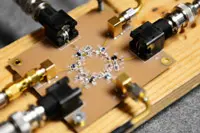Electronics News
Archive : 14 November 2014 год
 The University of Manchester has signed a memorandum of understanding with the National Physical Laboratory (NPL) to help accelerate the commercialisation of 'wonder material' graphene.
The University of Manchester has signed a memorandum of understanding with the National Physical Laboratory (NPL) to help accelerate the commercialisation of 'wonder material' graphene.
The agreement will see the two organisations work together on the development of graphene metrology, characterisation and standards vital to industry uptake, with a view to establishing a joint Centre of Excellence.
James Baker, business director of the National Graphene Institute at the University of Manchester, said: "With this new partnership, the University of Manchester and NPL are showing joint determination to lead the way in graphene applications.
"The metrology expertise based at NPL, paired with the world class academics, state of the art equipment and facilities at the UoM and NGI allows for viable graphene based products to come to the marketplace sooner."
Author
Laura Hopperton
Source: www.newelectronics.co.uk
 Researchers in the US have given the humble RF circulator a makeover. Not only is their prototype smaller, lighter, cheaper and more efficient, it's also claimed to be easily adapted to different frequencies.
Researchers in the US have given the humble RF circulator a makeover. Not only is their prototype smaller, lighter, cheaper and more efficient, it's also claimed to be easily adapted to different frequencies.
The team from the University of Texas at Austin says the device has the potential to double the useful bandwidth in wireless communications by enabling full-duplex functionality, meaning devices can transmit and receive signals on the same frequency band at the same time.
The current prototype measures 2cm – more than 75 times smaller than wavelength of operation – with the potential to be scaled down even further to just a few microns. It is based on materials commonly used in integrated circuits such as gold, copper and silicon, making it easy to integrate in the circuit boards of modern communication devices.
"We are changing the paradigm with which isolation and two-way transmission on the same frequency channel can be achieved," said project leader Andrea Alu. "We have built a circulator that does not need magnets or magnetic materials."
The researchers' device works by mimicking the way magnetic materials break the symmetry in wave transmission between two points in space, a critical function that allows magnetic circulators to selectively route radio waves.
With their new device, the researchers have accomplished the same effect, but they replaced the magnetic bias with a traveling wave spinning around the device.
"With this technology, we can incorporate tunable nonreciprocal components in mobile platforms," said Nicholas Estep, a doctoral student in the Department of Electrical and Computer Engineering. "In doing so, we may pave the way to simultaneous two-way communication in the same frequency band, which can free up chunks of bandwidth for more effective use."
What's more, because the design of the circulator is scalable and capable of circuit integration, it can potentially be placed in wireless devices.
"We envision micron-sized circulators embedded in mobile phone technology," Estep continued. "When you consider mobile phone traffic during high demand events such as a football game or a concert, there are enormous implications opened by our technology, including fewer dropped calls and clearer communications."
Author
Laura Hopperton
Source: www.newelectronics.co.uk
